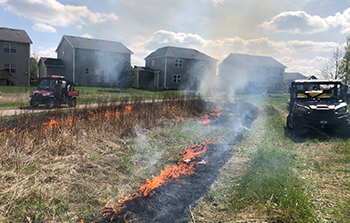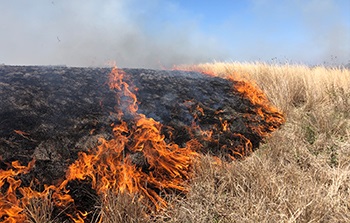A prescribed prairie burn is a management tool that is implemented by Hubbell Community Management (HCM), ensuring that early successional habitat will remain. Prairies rely on relatively frequent disturbance events, otherwise the plant community would continue to mature until eventually the prairie became a forest. Historical disturbances on the prairie were wildfires and grazing by large animals such as the American Bison. A prescribed burn is a planned event where a prairie manager applies fire to the landscape that simulates a wildfire and meets several management objectives including improving species composition, reducing prevalence of invasive or non-native plants, and resetting the ecological succession of the site.
Prescribed fires are applied throughout the nation and the world, as almost all ecosystems have a need for fire. In Iowa, prescribed fires are most often completed on prairies, although they also are completed in wooded areas. HCM uses prescribed fires on prairie outlots in the conservation communities we manage to improve and maintain the ecological integrity of those prairies. Another important factor to consider for a site is whether burning is practical. In some locations, a prairie just cannot be burned whether it be for logistical or safety reasons.
Burns are scheduled on a site-by-site basis according to several factors that the site might be exhibiting. Things considered are maturity of the plant community (ecological succession), plant species present, and when the site had last been burned. Burns are scheduled on a given site every 2 to 6 years. To date Hubbell Community Management has only completed burns in the spring, typically between April 1st and May 15th. Prescribed burning is extremely weather dependent, and we typically are not able to burn all sites that we hope to burn each year due to weather and the short timeline.
Prescribed fire planning typically begins the year prior to executing the burn. At Hubbell Community Management, we take a lot of things into consideration before starting a burn: identifying the site and reviewing all aspects of the site including accessibility, obstacles in and around the site, the amount of fuel present on the site, and any local restrictions or regulations.
When reviewing accessibility, we are looking at how easily the burn crew can access and maneuver the burn unit. It’s important that we know each site and how to get in and out safely. We need to understand what type of tools we will be able to use and whether the burn will be completed on foot, using an off-road vehicle, or if we can get a larger vehicle like a truck onto the site. The tools that we can operate on the site will influence what level of site preparations we implement on the site.

The unique obstacles of each site will influence how we complete our site prep and how much of the area can be burned safely. We are identifying things such as fences, desirable trees, proximity to homes, utility boxes, sheds, trampolines, etc. The fuel load of the site is also important to review. Different plants and densities of plants can influence how hot a site will burn. Some heavy fuels that we are looking for might include dense stands of warm-season grasses, cattails, and dense stemmed forbs such as cup plant. Following the review of the site, we install burn breaks by mowing the perimeter of the site short. We will also use firebreaks as a buffer around any obstacles identified previously. We also will mow shorter the heavy fuels in order to reduce the heat that those fuels will produce when burning. If those heavy fuels cannot be mowed short and they are too close to an obstacle, they will likely be excluded from the burn.
Once the site is prepared, we complete a burn plan and submit the plan as required to the city or county. Our burn plans include a site map, contact information, and access routes. Once we have received the required approval documentation, the burn may take place at any time during the burn season. Since this is a prescribed burn, the burn can only be completed when the weather conditions are “within prescription.”
These include wind speed and moisture. Burns cannot be carried out when wind conditions exceed a specified speed and cannot burn during a burn ban issued by the county. There also can be restrictions on wind direction to preserve visibility. When on-site prior to burning, the “burn boss” will review the weather conditions for favorability then contact the county emergency dispatch and local fire department, making them aware that a prescribed fire is taking place and the location of the fire.
The burn boss will review each site prior to lighting to ensure that the site preparation is sufficient to ensure a safe burn. All team members are provided with personal protective equipment to ensure their safety when interacting with the fire. The burn crew consists of a minimum of 4 members that operate as 2 teams. Each team has access to multiple hand tools, drip torches, and an all-terrain vehicle equipped with a large water tank and pump for extinguishing flames. As the fire burns, each team will use water or tools to put out the fire at the edge of the burn break. The fire will slowly creep into the wind. That practice is called the “back-burn”.
The burned area is extremely safe and is unlikely to re-ignite. The teams will continue to burn around the perimeter, allowing the fire to burn into the center. Once the fire is completed, the team will review the burn unit and put out any smoldering materials before moving to the next unit. When the burn crew is finished for the day, the burn boss will review all sites and again make sure that all smoldering material has been put out. Once they are sure that all sites are safe, they will call the county dispatch and local fire department notifying them that the prescribed fire is completed.
Even though these areas might seem like a good place to dispose of yard waste, any item that is dumped into these prairies adds unnecessary risk and increases the time it takes to safely burn an area. It is very common to see these items while burning: potting soil, pet waste, mulch, branch trimmings, and lawn clippings. These items will catch on fire and smolder, often near the firebreak. When burning we must ensure that all smoldering items are put out as we are burning, especially within a few feet of the edge of the fire. The burn crew will have to devote extra time and water to put out these smoldering materials. In addition to the problems that they will cause during a burn, dumping these things in a pile will also create a biological niche that is almost always filled by an undesirable weed.
HCM does more than just prairie burns and conservation. With 40-plus neighborhood associations and more than 5,000 homes in its portfolio, Hubbell Community Management has a presence in nearly every community in central Iowa. If you have any questions or would like to learn more about HCM, contact us!


ADD A COMMENT